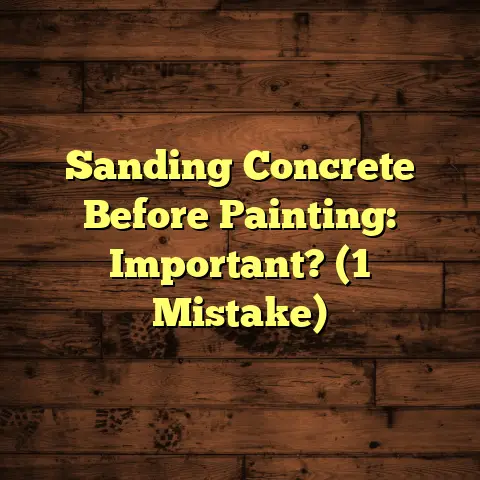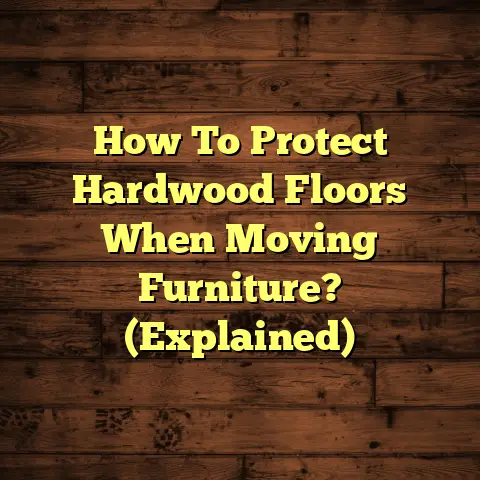Stop Creaky Floors: Pro Tricks Now! (5 Secrets!)
In today’s world, we’re all about smart homes, right? We’ve got voice-activated lights, thermostats that learn our habits, and security systems that can practically predict the future.
But all that tech can’t drown out the annoying creak…squeak…groan coming from your floors. Especially in multi-story homes, those noises can really kill the vibe.
Trust me, I get it. As a flooring contractor with over 15 years in the game, I’ve seen (and heard!) it all. That’s why I’m here to share my top 5 secrets to silence those creaky floors once and for all.
Let’s ditch the noise and get back to enjoying our smart, serene living spaces!
Section 1: Understanding Creaky Floors
Okay, let’s get down to the nitty-gritty. Why do floors creak? It’s not just old age; there’s actually some science behind it.
Think of your house as a living, breathing thing. It’s constantly expanding and contracting with changes in humidity and temperature. This movement puts stress on your floorboards, subfloor, and even the joists underneath.
Structural Issues
One of the biggest culprits is the natural settling of your home. Over time, foundations shift, and this can cause floorboards to rub against each other or against the subfloor.
Changes in humidity also play a HUGE role. Wood expands when it’s humid and contracts when it’s dry. This constant cycle can loosen nails and screws, creating gaps that lead to creaks.
Material Characteristics
Different flooring materials behave differently. Hardwood, for example, is more prone to creaking than some types of laminate because it’s a natural material that’s more susceptible to changes in moisture.
Tile, on the other hand, usually doesn’t creak itself, but if the subfloor underneath is uneven or poorly installed, the grout can crack, leading to movement and, yes, you guessed it, creaking.
Installation Problems
I can’t stress this enough: proper installation is KEY to preventing creaky floors. I’ve seen so many cases where shortcuts taken during installation came back to haunt homeowners (and their ears!) later on.
If the subfloor isn’t properly prepared, or if the flooring isn’t nailed or glued down correctly, you’re basically setting yourself up for a symphony of squeaks and groans.
Anecdote Time!
I once worked on a house where the homeowners were convinced they had a ghost. Every night, around the same time, they’d hear these loud creaks coming from the hallway.
Turns out, the previous contractor had used the wrong type of nails when installing the hardwood. Over time, the nails loosened, and the floorboards started rubbing against each other. No ghosts, just bad workmanship!
Did You Know?
According to a 2023 survey by the National Association of Realtors, 68% of homeowners said that floor condition was “very important” when considering buying a home. Creaky floors can definitely affect your home’s resale value!
Section 2: Pro Tip #1 – Identify the Source
Alright, so you’ve got creaky floors. The first step to fixing them is figuring out where the noise is coming from. This might sound obvious, but trust me, it’s not always as easy as it seems.
Sometimes the sound can travel, making it seem like it’s coming from one spot when it’s actually originating somewhere else entirely.
Tech-Savvy Approaches
Okay, so maybe you’re thinking, “Tech to the rescue!” And you’re not entirely wrong. While there isn’t a “creak-detecting app” (yet!), there are some smart home tools that can help.
For example, some smart sensors can monitor vibrations and movement in your floors. While they’re not specifically designed for creaks, they can alert you to areas where there might be excessive movement, which could be contributing to the noise.
Traditional Methods
Sometimes, the old-school methods are the best. Here’s my tried-and-true approach:
- Walk the Walk: Slowly walk across the floor, paying close attention to where the creaks are loudest. Try to isolate the specific spot that’s making the noise.
- Listen Up: Get down on your hands and knees (yes, really!) and have someone else walk over the suspected area. Sometimes, getting closer to the floor can help you pinpoint the exact source of the creak.
- Look Closely: Examine the floorboards around the noisy area. Are there any visible gaps? Are any of the boards loose or uneven? Use a flashlight to get a better look.
- Bounce Test: Gently bounce on the floor in different spots. Does the floor feel solid, or does it give way slightly? This can indicate a problem with the subfloor.
Important!
It’s crucial to differentiate between minor annoyances and more serious structural concerns. If you notice any of the following, it’s time to call in a professional:
- Large cracks in the floor or walls
- Sagging floors
- Doors that are sticking or difficult to close
- Visible water damage
These could be signs of a bigger problem that needs to be addressed by a qualified contractor.
Section 3: Pro Tip #2 – Tighten Loose Floorboards
So, you’ve found the source of the creak. Now what? If the problem is simply loose floorboards, you might be able to fix it yourself with a little elbow grease and the right tools.
Tools Needed
Here’s what you’ll need for this project:
- Screwdriver (or drill with screwdriver bit): Make sure you have the right size and type of screwdriver for the screws you’re using.
- Wood Glue: A good quality wood glue will help to secure the floorboards and prevent them from creaking in the future.
- Hammer: For gently tapping the floorboards into place.
- Nails (optional): If the screws aren’t doing the trick, you might need to add some nails for extra security.
- Safety Glasses: Protect your eyes from flying debris.
- Dust Mask: Avoid breathing in dust and other particles.
Step-by-Step Instructions
- Locate the Screws or Nails: Look for existing screws or nails around the creaky area. If they’re loose, try tightening them with a screwdriver.
- Add More Screws (if needed): If there aren’t enough screws or nails, add some more. Pre-drill pilot holes to prevent the wood from splitting.
- Apply Wood Glue: If the floorboards are still loose after tightening the screws, carefully lift the edge of the board and apply a small amount of wood glue to the subfloor.
- Secure the Board: Gently press the floorboard back into place and hold it there for a few minutes to allow the glue to set. You can use weights or clamps to keep the board in place.
- Clean Up: Wipe away any excess glue with a damp cloth.
Smart Home Integration?
Okay, I know what you’re thinking: “How can I use my smart home tech for this?”
Well, you could use a smart level to check the levelness of the floorboards before and after you tighten them. This can help you ensure that you’re not creating any new problems.
Also, some smart home security systems have sensors that can detect vibrations. You could use these sensors to monitor the floor for movement after you’ve made the repairs.
Safety First!
Before you start any repairs, make sure the area is clear of any obstacles. Wear safety glasses and a dust mask to protect yourself from debris. And if you’re not comfortable doing the repairs yourself, don’t hesitate to call a professional.
Section 4: Pro Tip #3 – Use Shims for Support
Sometimes, tightening the floorboards isn’t enough. If the subfloor is uneven or if there’s a gap between the floorboards and the subfloor, you might need to use shims to provide extra support.
What are Shims?
Shims are thin, tapered pieces of wood or plastic that are used to fill gaps and provide support. They’re commonly used in construction to level surfaces and prevent movement.
How to Use Shims
- Locate the Gap: Find the area where there’s a gap between the floorboard and the subfloor. You can use a flashlight to help you see.
- Choose the Right Shim: Select a shim that’s the right size and thickness for the gap. You can buy shims at most hardware stores.
- Insert the Shim: Carefully insert the shim into the gap. You might need to use a hammer to gently tap it into place.
- Test the Floor: Walk over the area to see if the creaking is gone. If not, you might need to add more shims.
- Trim the Excess: Once you’re satisfied that the shims are providing enough support, trim off any excess material with a utility knife.
Pro Tip:
For larger gaps, you can use multiple shims stacked on top of each other. Just make sure they’re securely glued together.
Older Homes
Shimming is particularly useful in older homes where the subfloor might be uneven or damaged. It’s a relatively simple and inexpensive way to provide extra support and eliminate creaks.
Smart Home Integration (Again!)
Remember those smart sensors that can detect vibrations? You can use them to monitor the floor after you’ve installed the shims. If you notice any new movement, you might need to adjust the shims or add more.
Section 5: Pro Tip #4 – Soundproofing Solutions
Okay, so you’ve tried tightening the floorboards and using shims, but the creaking is still there. What now? It might be time to consider soundproofing solutions.
Types of Soundproofing Materials
There are a variety of materials that can be used to soundproof floors, including:
- Acoustic Panels: These panels are designed to absorb sound and reduce noise levels. They can be installed on the walls or ceiling.
- Underlayment: This is a layer of material that’s installed underneath the flooring. It helps to dampen sound and reduce vibrations.
- Soundproof Mat: These mats are specifically designed to absorb sound and reduce noise levels.
Installation Tips
- Acoustic Panels: Follow the manufacturer’s instructions for installation. Make sure the panels are securely attached to the wall or ceiling.
- Underlayment: Install the underlayment before you install the flooring. Make sure the underlayment is properly sealed to prevent moisture damage.
- Soundproof Mat: Simply place the mat under the area.
Smart Home Soundproofing
Some smart home systems can integrate with soundproofing products to enhance the overall acoustic experience of your home. For example, you can use a smart speaker to play white noise or nature sounds to mask the sound of creaky floors.
Section 6: Pro Tip #5 – Professional Help
Okay, so you’ve tried everything, and the creaking is still driving you crazy. It might be time to call in the professionals.
Signs that Professional Help is Needed
- Extensive Structural Issues: If you notice large cracks in the floor or walls, sagging floors, or doors that are sticking, it’s time to call a professional.
- Widespread Creaking: If the creaking is widespread and you can’t seem to pinpoint the source, a professional can help you diagnose the problem.
- Water Damage: If you see signs of water damage, such as stains or mold, it’s important to call a professional to assess the damage.
Choosing the Right Professional
- Get Referrals: Ask friends, family, or neighbors for referrals to reputable flooring specialists or contractors.
- Check Credentials: Make sure the professional is licensed and insured.
- Ask Questions: Ask the professional about their experience, their approach to fixing creaky floors, and their pricing.
- Get a Written Estimate: Before you hire a professional, get a written estimate that outlines the scope of the work and the cost.
Long-Lasting Solutions
Leveraging professional expertise ensures long-lasting solutions, maintaining the integrity of your smart home. They can identify underlying issues and provide effective fixes.
Conclusion
So, there you have it: my top 5 secrets to stop creaky floors! Remember, while smart home technology is great, it’s important to address fundamental issues like creaky floors to create a truly comfortable and enjoyable home environment.
Take action based on these tips, and you’ll be well on your way to a more peaceful living space. With a combination of traditional solutions and modern technology, you can create a harmonious home that’s both smart and serene.
Now go forth and silence those creaks! You deserve a quiet, comfortable home.





